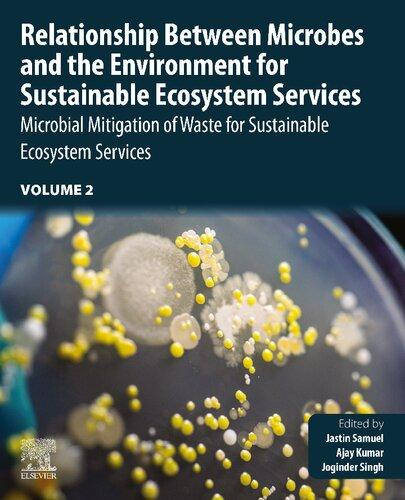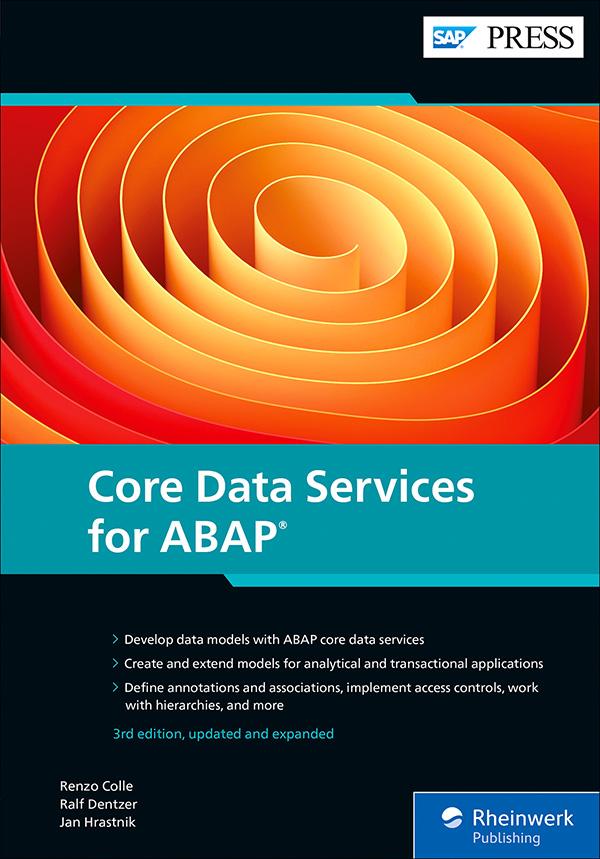2 Fundamentals of CDS Data
Modeling
2.1 Overview of CDS Models
2.2 Overview of CDS View Syntax
2.3 Key Fields
2.4 Cast Operations
2.5 Typed Literals
2.6 Simple Types
2.7 Case Statements
2.8 Session Variables
2.9 Client Handling
2.10 Select Distinct Statements
2.11 Union Views
2.11.1 Union Definitions
2.11.2 Union and Union All Logic
2.12 Intersect and Except Statements
2.13 Joins
2.14 SQL Aggregation Functions
2.15 Projection Fields
2.16 Parameters
2.17 Reference Fields
2.18 Conversion Functions for Currencies and Quantity Units
2.19 Provider Contracts
2.20 Entity Buffer Definitions
2.21 Summary
3 Associations
3.1 Define Associations
3.2 Expose Associations
3.3 Model Compositional Relations
3.4 Model M:N Relations
3.5 Project Associations
3.6 Use Associations in CDS Views
3.6.1 Define Path Expressions
3.6.2 Implicit Joins
3.6.3 Cardinality Changes Resulting from Path Expressions
3.6.4 Restrictions for Defining Path Expressions
3.7 Use Associations in ABAP Code
3.8 Summary
4 Annotations
4.1 Annotation Definitions
4.1.1 Syntax Overview
4.1.2 Annotation Names
4.1.3 Annotation Types and Values
4.1.4 Enumeration Values
4.1.5 Annotation Default Values
4.1.6 Annotation Scopes
4.2 Effects of Annotations
4.3 Propagation Logic for Annotations
4.3.1 Propagation Logic within Simple Type Hierarchies
4.3.2 Propagation Logic of Element Annotations
4.3.3 Consistency Aspects
4.4 Metadata Extensions
4.5 Active Annotations
4.6 Summary
5 Access Controls
5.1 Fundamentals of Access Controls
5.2 Mode of Action of Access Controls
5.3 Implementation Patterns for Access Controls
5.3.1 Implement Access Controls with Path Expressions
5.3.2 Inherit Implementation of Access Controls
5.3.3 Implement Access Controls without Using Authorization Objects
5.3.4 Implement Access Controls for Analytical Queries
5.3.5 Implement Access Controls for Transactional Applications
5.3.6 Implement Access Controls on the Field Level
5.3.7 Change Access Controls of SAP-Delivered CDS Models
5.3.8 Block Standard Data Selections from CDS Models
5.3.9 Decouple Access Controls from User Input
5.3.10 Map CDS Fields onto Fields of Authorization Objects Using Indirection
6.3.1 OData UI Services 6.3.2 OData Web API Services
6.3.3 InA UI Services
6.3.4 SQL Web API Services
6.4 Testing Business Services
6.4.1 Use OData Service URLs
6.4.2 Use UI Previews
6.5 Summary
7 Native SAP HANA Functions in CDS
7.1 Implementation of a CDS Table Function
7.2 Application Scenarios
7.3 Improve Performance and Avoid Errors
7.4 Summary
8 Modeling Application Data
8.1 Application Architecture in SAP S/4HANA
8.2 Field Labels
8.2.1 Determination of a Field Label
8.2.2 Length of a Field Label
8.3 Field Semantics
8.3.1 Quantities and Amounts
8.3.2 Aggregation Behavior
8.3.3 System Times
8.3.4 Text and Languages
8.3.5 Information for the Fiscal Year
8.4 Foreign Key Relations
8.5 Text Relations
8.6 Composition Relations
8.7 Time-Dependent Data
8.8 Summary
9 The Virtual Data Model of SAP S/4HANA
9.1 Why a Virtual Data Model?
9.2 SAP Object Types and Object Node Types
9.3 Categories of CDS Entities in the Virtual Data Model
9.3.1 Basic Interface Views
9.3.2 Composite Interface Views
9.3.3 Consumption Views
9.3.4 Other Types of VDMs
9.4 Naming in the Virtual Data Model
9.5 Basic Interface View for the Sales Order
9.5.1 View Annotations
9.5.2 Structure of the Sales Order View
9.5.3 Specialization
9.5.4 Element Annotations
9.6 Tips for Finding Virtual Data Model Views
9.6.1 SAP Business Accelerator Hub and View Browser App
9.6.2 Search in ABAP Development Tools
9.6.3 Search Views with Specific Annotations
9.6.4 ABAP Where-Used List
9.7 Summary
10 Modeling Analytical Applications
10.1 Analytics in SAP S/4HANA
10.2 Analytical Views
10.2.1 First Analytical Cube View
10.2.2 Test Environment for Analytical Views
10.2.3 Analytical Cube Views
10.2.4 Analytical Dimension Views
10.2.5 Analytical Model in the Test Environment
10.2.6 Consistency of the Analytical Model
10.3 Analytical Queries
10.3.1 Definition of an Analytical Query
10.3.2 Initial Layout of a Query
10.3.3 Filter, Select Options, Parameters
10.3.4 Calculation of Measures
10.3.5 Restricted Measures
10.3.6 Exception Aggregation
10.3.7 Currencies and Conversion
10.3.8 Analytical Query Selecting from Dimension Views
10.4 Analytical Infrastructure
10.5 Summary
11 Modeling Transactional Applications
11.1 Transactional Applications
11.2 Transactional Infrastructure in SAP S/4HANA
11.3 Transactional Object Models
11.3.1 Object Models
11.3.2 Access Controls
11.4 Behavior Definitions
11.4.1 Create Behavior Definition
11.4.2 Behavior Pool and Handler Implementation
11.4.3 Consumption via EML
11.4.4 Static Field Control
11.4.5 Numbering
11.4.6 Exclusive Locks
11.4.7 Authorization Checks
11.4.8 Authorization Contexts and Privileged Access
11.4.9 Associations
11.4.10 Actions
11.4.11 Functions
11.4.12 Data Determinations and Validations
11.4.13 Dynamic Feature Control
11.4.14 Mappings
11.4.15 Calculated Fields
11.4.16 Prechecks
11.4.17 HTTP ETags
11.4.18 Draft
11.4.19 Side Effects
11.4.20 Change Documents
11.4.21 Events
11.5 Transactional Projection Object Models
11.5.1 Projection Object Models
11.5.2 Access Control
11.5.3 Denormalized Fields
11.5.4 Localized Elements
11.5.5 Calculated Fields/Virtual Elements
11.6 Define Interface Behavior Definition
11.6.1 Create Interface Behavior Definition
11.6.2 Static Feature Control
11.6.3 Operations
11.6.4 Draft, ETag, and Side Effects
11.6.5 Events
11.6.6 Consumption via EML
11.6.7 Release for Consumption
11.7 Define Projection Behavior
Definition
11.7.1 Create Projection Behavior Definition
11.7.2 Actions and Functions
11.7.3 Prechecks
11.7.4 Augmentation
11.7.5 Side Effects
11.7.6 Events
11.7.7 Consumption via EML
11.8 Runtime Orchestration
11.8.1 Interaction Phase Operation Flow
11.8.2 Save Phase Operation Flow
11.8.3 Runtime Component Overview
11.8.4 Consumption via OData
11.9 SAP Fiori and OData Consumption
11.9.1 OData Service for Web API Consumption
11.9.2 OData Service for UI Consumption
11.10 SAP Event Mesh and Local Event Handlers
11.10.1 Local Event Handler
11.10.2 SAP Event Mesh
11.11 Summary
12 Hierarchies in CDS
12.1 Hierarchy Categories and Basics
12.2 Annotation-Based Parent-Child Hierarchies
12.2.1 Example of a Parent-Child Hierarchy
12.2.2 Determination of a Hierarchy
12.2.3 Test a Hierarchy
12.3 CDS Hierarchies
12.3.1 Data for an Example of a Reporting Line Hierarchy
12.3.2 Define the CDS Hierarchy
12.3.3 Hierarchy Attributes
12.3.4 Visualization of a Hierarchy
12.3.5 Hierarchy with an Orphaned Node
12.3.6 Hierarchy with Multiple Parent Nodes
12.3.7 Hierarchy with Cycles
12.3.8 Further Options for Defining Hierarchies
12.3.9 CDS Hierarchies in ABAP SQL
12.3.10 OData Service for CDS Hierarchies
12.4 Summary
13 CDS-Based Search
Functionality
13.1 Modeling Value Helps
13.1.1 Modeling Elementary Value Helps
13.1.2 Integrating Value Help CDS Views
13.1.3 Collective Value Helps
13.1.4 Exposing Value Helps in OData Services
13.1.5 Using Value Helps
13.2 Free-Text Search Functionality in OData Services
13.3 Enterprise Search Functionality
13.3.1 Define Enterprise Search Models
13.3.2 Adapt Enterprise Search Models from SAP 13.4 Summary
14 Lifecycle and Stability
14.1 Stability Contracts 14.2 Lifecycle of Development Objects
14.3 Deprecation of Development Objects
14.4 Use of CDS Models and Supported Capabilities
14.5 Summary
15 Extensions of CDS Views and Other Entities
15.1 Solution Variants and ABAP Language Versions
15.2 Stable CDS Extensions
15.2.1 Stable Extensions of CDS Views
15.2.2 Example: Stable Extension Points
15.2.3 Example: Extension with Custom Fields
15.2.4 CDS Extensions in Product Variants
15.3 Extensions of Transactional Models
15.3.1 Add Fields to an Entity
15.3.2 Add Application Logic
15.3.3 Extend Action and Function Parameters and Results
15.3.4 Extend Behavior
15.3.5 Add Composition Child Entity
15.4 Summary
16 Automated Testing
16.1 Test Logic of Data Selections
16.1.1 Fundamentals of the Test Double Framework
16.1.2 Test Sample Overview
16.1.3 Test Implementations of CDS Views
16.1.4 Test ABAP Logic with SQL Accesses to CDS Views
16.1.5 Test Code Generation Functions
16.2 Test Logic of Transactional Applications
16.2.1 Test Behavior Handler
16.2.2 Test Events and Event Payloads
16.2.3 Test Event Handler
16.2.4 Tests via EML Interface
16.3 Summary
17 Troubleshooting
17.1 Performance Aspects
17.1.1 Static View Complexity
17.1.2 Calculated Fields
17.1.3 CDS Models in ABAP Code
17.1.4 Performance Tests
17.1.5 Analysis Tools
17.2 Pitfalls
17.2.1 Null Values
17.2.2 Data Types
17.2.3 Decimal Shift Logic for Amounts
17.3 Troubleshoot Implementations of CDS Models
17.3.1 Syntax Checks
17.3.2 Consistency Checks of Frameworks
17.4 Troubleshoot Activation Issues
17.4.1 Online Activation
17.4.2 Mass Checks and Repairs
17.5 Examine ABAP RESTful Application Programming Model Applications
17.6 Summary
A CDS Annotation Reference
B Migration to the ABAP
RESTful Application Programming Model
C The Authors
Index Service Pages
Legal Notes
Preface
ABAP's core data services (CDS) technology forms the basis of the ABAP platform’s modern programming model and is therefore an important part of SAP’s current technology strategy. Among other things, as an extension of SQL, this technology allows users to leverage the features of the SAP HANA database. ABAP CDS and its annotations can be used to enhance the model with information that can be optimally integrated into analytical applications and web interfaces for cloud applications or user interfaces (UIs) via OData as a model-based protocol. CDS also serves as a foundation for the new ABAP RESTful application programming model. Therefore, CDS and the programming model based on it form the basis of SAP Fiori applications, which embody the new standards for the modern user experience (UX) of SAP applications.
SAP S/4HANA, the next generation business suite, is also based on CDS in the form of the virtual data model (VDM).
In this book, we describe the use of CDS from the perspective of SAP S/4HANA and its overall architecture. Therefore, we not only describe the technical aspects of CDS but also the motivation behind the applied approaches. We use examples from application development and supplement them with recommendations for the successful implementation of your own projects, which go far beyond discussing purely functional aspects.
We cover the most important aspects and functions of ABAP CDS, which are used in concrete use cases in the SAP S/4HANA environment (up to date for release SAP S/4HANA 2023). For a technical description of all CDS functions, you can refer to the SAP standard documentation. This book also provides the relevant basis (in the respective version of the ABAP platform) for the applicable syntax and scope of functions supported.
The CDS-based programming model is relatively new and is therefore still subject to changes and significant further enhancements and features. Especially in the field of transactional applications and the ABAP RESTful application programming model, the development of the programming model is still evolving. Particularly in this area, we expect the implementation to become more efficient and the range of features and functions to be extended significantly in the future. You should always consider this evolution when implementing your own projects.
With this book, we aim to give you an overview of the CDSbased programming model and possible use cases. The knowledge we provide will enable you to define CDS models based on the basic rules and recommendations that the SAP standard development follows, to use them in a reasonable way in your applications, and to enhance the SAP S/4HANA standard applications. By the time you’ve finished the book, you should have developed comprehensive knowledge of the underlying concepts, learned how SAP uses these concepts in SAP S/4HANA, and gained a practical understanding of how these concepts can be applied when building your own applications.
The book is primarily aimed at ABAP developers who want to develop or enhance ABAP-based applications for use in OData application programming interfaces (APIs), in analytics or in SAP Fiori UIs. Basic knowledge of ABAP development and SQL is required. However, if you’re a newcomer to the ABAP and SQL world, the book will help you create your first applications and services with the help of CDS models. You can very quickly develop appealing analytical applications and interfaces, as well as purely reading applications, without writing ABAP code yourself.
Still, to enter the transactional world with the ABAP RESTful application programming model, using ABAP as a programming language for business logic is a prerequisite; in addition, a lot of model-driven infrastructure support is available. We’ll only deal with these topics on a very basic level in the context of this book. We also won’t go into detailed discussions regarding the SAP Fiori UI and will only use simple examples to show how you can easily create an OData service and an SAP Fiori UI based on your CDS models. However, you can also deepen your knowledge by studying the relevant literature or SAP documentation in parallel.
In the third edition of this book, the newest developments and features of the ABAP platform are reflected and included. With this, the structuring of the book was also reworked. The chapter on transactional applications (Chapter 11) has been enhanced significantly to cover the newest features of the ABAP RESTful application programming model (e.g., business events) and much more. We have provided a completely new chapter for the software lifecycle and stability of CDS and ABAP RESTful
application programming model artifacts; based on this, we’ve reworked the complete chapter on extensions of applications. The other chapters have all been updated accordingly, especially the chapter for test automation and troubleshooting, which has been enhanced to also cover transactional applications. Further, all CDS-based examples are now based on CDS view entities (CDS V2), the new generation of CDS views discussed and explained in the previous editions.
The descriptions and examples refer to the current state of the art (up to date for release SAP S/4HANA 2023, but also the related SAP S/4HANA Cloud, public edition). Most of the concepts and basics also work in general for ABAP cloudbased applications independent of SAP S/4HANA. We’ve created them to the best of our knowledge but can’t completely exclude errors. If in doubt, consult the official SAP documentation.
We use ABAP in Eclipse (ABAP Development Tools [ADT]) as our development environment. English is the default development language for development objects or comments in source code. All texts relevant for the end user can be translated, of course, and thus any application can also be localized.
Structure of the Book
This section provides a rough overview of the chapter structure and the content of the individual chapters. The first four chapters should be read sequentially as a foundation because all other concepts and chapters are
based on them. You can then jump back and forth between the individual chapters according to your needs and interests.
Chapter 1 shows you how to define your first simple CDS views quickly. In addition to the essential parts of a CDS view, we’ll also briefly introduce the most important development tools.
Chapter 2 provides the fundamentals and technical basics of CDS data models. For this purpose, we present the relevant CDS artifacts from the developer’s point of view, including their components, using modeling examples.
In Chapter 3, we explain the basics, definition, and usage of associations in CDS models via ABAP implementation and special association types, such as compositions.
In Chapter 4, we explain the basics of CDS annotations and their propagation logic using examples. CDS annotations enrich the data models with semantic information. This information is interpreted by CDS consumers and controls, and then influence, for example, the presentation on the UI or the aggregation behavior of an analytical application.
In Chapter 5, we deal with the authorizations for accessing the data exposed by the CDS models. Access controls using the CDS data control language (DCL) enable you to restrict the selection results of CDS views according to the user’s authorizations via classic ABAP authorization objects. We explain the basics of CDS access controls and demonstrate their concrete use.
In Chapter 6, you get an insight into the modeling and definition of business services based on a special view type,
projection views, service definitions, and service bindings focusing on OData protocol–based bindings. Business services allow you to expose your CDS models to external consumers.
In Chapter 7, we examine CDS table functions, which enable you to integrate native SAP HANA functions into the CDS view stack using SQLScript. We illustrate the modeling of CDS table functions and highlight their special features.
Chapter 8 provides an overview of the application architecture in SAP S/4HANA and the positioning of CDS within this architecture. Using examples, we show how important aspects of application data are modeled with CDS, such as field labels, field semantics, foreign key relationships, language-dependent texts, entity compositions, and time-dependent data.
In Chapter 9, we explain the virtual data model (VDM) of SAP S/4HANA, which is formed by selected CDS views that meet centrally defined quality and modeling aspects. The modeling rules used are presented schematically via examples. The explanations are intended to help you understand the CDS models delivered by SAP and enable you to use them purposefully in your own developments.
In Chapter 10, we focus on analytical applications. We briefly discuss the SAP S/4HANA architecture for embedded analytics and explain how CDS views can be used for this. The analytical model used is based on a consistent network of interlinked analytical CDS views and exposed via analytical queries. We use examples to show you the relationships between these CDS views and their special features and analytical calculations.
In Chapter 11, we then deal with transactional applications. In addition to modeling and executing read accesses, CDS also is the basic data model for enabling transactional processing. The integration of a transactional runtime based on the ABAP RESTful application programming model and the special aspects of transactional applications, such as locking, authorizations, feature control, business logic (e.g., actions, determinations, and validations), and business events are explained using appropriate examples. In addition, the draft concept is introduced and explained in detail.
In Chapter 12, we introduce two options for the flexible modeling in CDS of hierarchical structured data with concrete examples. The hierarchical models are interpreted directly by the underlying infrastructure (e.g., in analytical applications) or can be used as powerful functions for navigation or aggregation of these hierarchies in your ABAP implementations.
Chapter 13 shows you that CDS can also be used as a basis for modeling value helps and free-text searches. You’ll learn how the value helps and search functions can be integrated and used in certain use cases, for example, for OData exposure.
Chapter 14 addresses the question of lifecycle and stability of CDS and ABAP RESTful application programming model artifacts as well as if and how these can be changed within an upgrade or hot fix. Stability contracts provide security for developers and consumers of these artifacts. A defined lifecycle controls the release of these artifacts as well as their deprecation and replacing successors.
Chapter 15 provides an overview of the possibilities for modification-free enhancements by customers and partners. In SAP S/4HANA Cloud, public edition, special tailored apps support an experienced user with special authorizations— the key user—in performing necessary enhancements. These enhancements must be kept stable from a lifecycle perspective to ensure smooth software. This requires special preparations during application development and adherence to stability contracts. Further developer extensibility is explained by using CDS view extensions.
Chapter 16 introduces the creation of automated tests for your CDS models as well as the transactional runtime and its implementations. The test double framework presented here allows you to exchange the data sources of CDS views as well as certain parts of the behavior implementation and thus to decouple the test execution from the actual persistent data or productive application logic. We explain test automation with the test double frameworks using examples.
In Chapter 17, we recommend practical ways for troubleshooting to find and correct errors and problems in the context of CDS and the ABAP RESTful application programming model. We describe the tools relevant for troubleshooting and explain how to use them. In addition, we illustrate some pitfalls that you may come across when developing your CDS models.
An overview of the CDS annotations presented in this book is included in Appendix A as a quick reference. For an overview of all available CDS annotations, refer to the SAP documentation.












